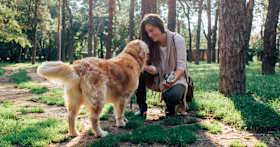What Vaccines do Dogs Need?
Yes, you need to vaccinate your dog. Consider this your guide to their must-have vaccines, the optional ones, as well as vaccine schedules.
Yes, you need to vaccinate your dog. Consider this your guide to their must-have vaccines, the optional ones, as well as vaccine schedules.
by Adrienne A. Kruzer, BBA, RVT, LVT, | June 2, 2025

Danil Nevsky / Stocksy
Dogs are susceptible to several diseases, but you can protect them from some threats by vaccinating them. Vaccines help your dog’s immune system fight off specific diseases, but they frequently won’t need all canine vaccines.
Core vaccines are those highly recommended for all dogs and include rabies, parvovirus, parainfluenza, hepatitis, distemper, and leptospirosis. Non-core vaccines are only recommended for some dogs, and include those for Lyme, Bordetella, and influenza. Your dog’s veterinarian will help you determine which non-core vaccines your dog needs and ensure they get on the right vaccine schedule.
TLDR: All dogs need the core vaccines: distemper, parvovirus, leptospirosis, parainfluenza, canine hepatitis, and rabies, which is legally required in most states. Your vet may also recommend non-core vaccines such as Bordetella, Lyme, and flu.
If your dog spends the majority of their time in your home and yard, you may think they’re not at risk for contracting the diseases. Unfortunately, any dog who goes outside is at risk, and vaccines can help protect them. Your veterinarian will recommend the vaccines that are most important for your dog, based on their lifestyle, location, and other risk factors.
If you’re leery about vaccination because you’re concerned about your dog reacting negatively to them, be assured that fatigue and soreness at the injection site are common but should only last a day or so. Other side effects — such as vomiting, diarrhea, or difficulty breathing are far less common — and vaccine benefits far outweigh the low likelihood of these reactions occurring. If you are concerned about potential vaccine reactions, a premedication (typically an antihistamine and/or a steroid) can be administered before vaccinating to help minimize most side effects.
If you’re wondering which shots dogs need, the American Animal Hospital Association (AAHA) deems certain core vaccines essential for all dogs, regardless of their exposure risk. (Vaccines that aren’t considered core vaccines are called non-core vaccines.) The core vaccines your dog will need include the following.
The rabies vaccine is legally required in most states. Rabies affects the central nervous system and is typically spread through bites from infected animals. Seizures, drooling, paralysis, aggression, and ultimately death may occur in infected dogs, since there is no treatment or cure for unvaccinated canines.
The “D” part of the combination vaccine, commonly known as the DAPP or DHPP vaccine, represents distemper, a virus that infects a dog’s lymphatic tissues and subsequent bodily systems. The distemper virus causes respiratory issues, seizures, vomiting, diarrhea, and fevers. It most often infects young dogs.
Infectious canine hepatitis is caused by an adenovirus spread through urine as well as nasal and eye discharge. The hepatitis vaccine is the “H” or “A” part of the DHPP or DAPP combination vaccine, and helps prevent your dog from being infected by the virus. In mild cases, a pup may experience respiratory symptoms, a decreased appetite, fever, and eye cloudiness. In severe cases — which typically occur only in puppies — vomiting, diarrhea, jaundice, edema, and even death can occur.
A common, very contagious disease in unvaccinated puppies, parvo is caused by the canine parvovirus type 2 (CPV) and can be found in nearly any kind of environment. The first “P” in the DHPP or DAPP combination vaccine stands for parvovirus. The vaccines help prevent this virus from infecting your dog. Symptoms of the disease include bloody diarrhea, vomiting, fever, lethargy, a lack of appetite, and even death.
Parainfluenza is an upper respiratory disease that can infect any dog. It is easily spread through coughing and can also cause a fever, lack of energy, loss of appetite, and nasal discharge. The canine parainfluenza vaccine can help prevent serious symptoms from developing and is typically indicated by the second “P” in the DHPP or DAPP combination vaccines as well as with the Bordatella non-core vaccine.
Often referred to as lepto, leptospirosis is caused by a Leptospira bacteria and is easily spread through contaminated water. It can cause a variety of symptoms, including vomiting, diarrhea, joint stiffness, and even kidney failure. The lepto vaccine for dogs can be given alone or as part of the DHLPP or DALPP combination vaccines.
Unlike core vaccines, non-core dog vaccines are not recommended for all dogs. Your veterinarian will recommend which of these vaccines, if any, your dog needs based on their lifestyle, environment, and other risk factors.
Often called the kennel cough vaccine, the Bordatella vaccine helps prevent respiratory disease caused by Bordatella bacteria. It is highly contagious and spreads through the air. There are injectable, oral, and intranasal versions of this vaccine available.
Similar to the Bordatella vaccine, the canine influenza vaccine helps prevent respiratory disease. Unlike Bordatella though, influenza is a virus and has two primary strains, H3N8 and H3N2. Influenza can cause complications in at-risk dogs, such as puppies, seniors, flat-faced dog breeds, and dogs with underlying heart and health issues.
Lyme disease is caused by a bacterium called Borrelia burgdorferi and is spread through certain kinds of tick bites. The disease can cause joint swelling, lameness, swollen lymph nodes, and even serious kidney disease. If your dog is at risk for this disease, your veterinarian may recommend the Lyme vaccine for them.
Vaccine boosters are usually needed throughout the life of your dog. Since a vaccination does not protect your dog forever, boosters increase the amount of antibodies (for any given disease) in your dog. Some vaccines only require a booster once every three years, while others need boosters annually. Alternatively, some vaccines have titer tests available to check if your dog’s immunity to a disease is high enough that they don’t need a booster.
If you have a new puppy or have adopted an adult dog with an unknown vaccine history, they will require more than one vaccine on a specific schedule to ensure they are appropriately protected. Core vaccines that your puppy or adult dog needs should be administered according to the following schedules.
Canine Core Vaccine Schedule
Vaccine | Starting Age | Schedule | Booster |
Distemper | 6 to 8 weeks | At least 3 doses every 2 to 4 weeks until 16 weeks of age, or 2 doses at 2 to 4 weeks apart if more than 16 weeks of age | 1 year after last dose, then every 3 years |
Rabies | As required by law | As required by law, but typically only once | As required by law, but typically 1 year after first dose, then every 3 years |
Hepatitis | 6 to 8 weeks | At least 3 doses every 2 to 4 weeks until 16 weeks of age, or 2 doses at 2 to 4 weeks apart if more than 16 weeks of age | 1 year after last dose, then every 3 years |
Parvovirus | 6 to 8 weeks | At least 3 doses every 2 to 4 weeks until 16 weeks of age, or 2 doses at 2 to 4 weeks apart if more than 16 weeks of age | 1 year after last dose, then every 3 years |
Parainfluenza | 6 to 8 weeks | At least 3 doses every 2 to 4 weeks until 16 weeks of age, or 2 doses at 2 to 4 weeks apart, if more than 16 weeks of age | 1 year after last dose, then every 3 years |
Leptospirosis | 2 doses at 2 to 4 weeks apart, starting at 12 weeks | Two doses at 2 to 4 weeks apart, regardless of age | Annually |
No, vaccines have a low likelihood of causing any serious side effects in your dog. Soreness at the injection site and lethargy are typically the only side effects. If you are concerned about less common but more serious side effects, such as difficulty breathing, vomiting, or diarrhea, ask your veterinarian about giving your dog a premedication of antihistamines and/or steroids.
Adoption fees will vary greatly depending on breed, age, health status, location, and source of the dog. Some dogs can be adopted for free from private individuals who didn’t purposefully breed their dogs. Adoption fees from rescues and shelters are often around a couple of hundred dollars, since the dogs are usually already vaccinated and spayed/neutered before being adopted. Adopting a dog from a breeder will usually cost much more. After adoption fees, you’ll need to consider the average cost of having a dog. You’ll spend more on food, supplies, and veterinary care, but there may be vet financial assistance available.
All dogs should be vaccinated for rabies, but once is not enough. After your dog gets their first rabies shot as a puppy, they will likely need a booster shot one year later. After that first booster shot, though, rabies shots are usually only needed once every three years, depending on your state’s laws.
“2022 AAHA Canine Vaccination Guidelines.” AAHA, 15 Aug. 2022, www.aaha.org/resources/2022-aaha-canine-vaccination-guidelines.
AVMA. “Leptospirosis in Dogs | American Veterinary Medical Association.” Www.avma.org, 2025, www.avma.org/resources-tools/pet-owners/petcare/leptospirosis.
AVMA. “Lyme Disease | American Veterinary Medical Association.” Www.avma.org, 2024, www.avma.org/resources-tools/pet-owners/petcare/lyme-disease-dogs.
“Bordetella Bronchiseptica | Merck Animal Health USA.” Merck Animal Health USA, www.merck-animal-health-usa.com/condition/bordetella-bronchiseptica.
“Canine Distemper.” Merck Animal Health USA, www.merck-animal-health-usa.com/nobivac/canine-distemper.
“Canine Influenza | American Veterinary Medical Association.” Www.avma.org, www.avma.org/resources-tools/pet-owners/petcare/canine-influenza.
“Canine Parainfluenza.” Merck Animal Health USA, www.merck-animal-health-usa.com/condition/canine-parainfluenza.
Cornell University College of Veterinary Medicine. “Canine Parvovirus | Cornell University College of Veterinary Medicine.” Www.vet.cornell.edu, 2024, www.vet.cornell.edu/departments-centers-and-institutes/baker-institute/research-baker-institute/canine-parvovirus.
Weir, Malcolm, et al. “Infectious Hepatitis (Adenovirus) in Dogs.” Vca_corporate, 2009, vcahospitals.com/know-your-pet/hepatitis-adenovirus-infection-in-dogs.
“Canine Influenza the Dog Flu | VCA Animal Hospital.” Vca, vcahospitals.com/know-your-pet/canine-influenza-the-dog-flu.

Adrienne Kruzer is an accomplished veterinary technician and writer with over 15 years of hands-on experience caring for domestic and exotic animals.

Pet Wellness

Pet Wellness

Pet Wellness

Adoption Advice
Your puppy’s outdoor adventures await — but vaccinations come first.

Pet Wellness
These tips on maintaining good hygiene for your dog are crucial for their health, comfort, and overall well-being.

Pet Wellness
Regular vet visits are key to keeping your pet healthy. Here’s what happens during a checkup, when to get them, and what to bring.

Adoption Advice
A diagnosis in a pup may seem scary. But in most cases, dogs with Lyme can live a long, normal life.

Adoption Advice
Dealing with high vet bills? See assistance options for affordable pet care. Get the support your pet needs without breaking the bank.

Adoption Advice
New rescue dog? Don’t panic — here’s your survival guide for the first few days and how to connect with your new best friend.